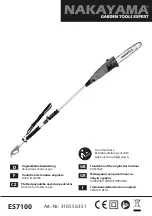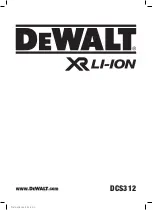
5
Make sure your extension cord is in good
condition. Use only 3-wire extension
cords that have 3-prong grounding-
type plugs and 3-pole receptacles that
accept the tool’s plug
.
•
An extension cord must have
adequate wire size (AWG or American
Wire Gauge) for safety.
The smaller the
gauge number of the wire, the greater the
capacity of the cable, that is 16 gauge has
more capacity than 18 gauge. An undersized
cord will cause a drop in line voltage resulting
in loss of power and overheating. When using
more than one extension to make up the total
length, be sure each individual extension
contains at least the minimum wire size. The
following table shows the correct size to use
depending on cord length and nameplate
ampere rating. If in doubt, use the next heavier
gauge. The smaller the gauge number, the
heavier the cord.
CAUTION:
Blades coast after turn off.
Serious personal injury may result.
WARNING:
ALWAYS wear proper
personal hearing protection that conforms to
ANSI S12.6 (S3.19) during use.
Under some
conditions and duration of use, noise from this
product may contribute to hearing loss.
WARNING:
ALWAYS use proper eye
protection.
All users and bystanders must
wear proper eye protection that conforms to
ANSI Z87.1.
WARNING:
ALWAYS USE SAFETY
GLASSES.
Everyday eyeglasses are NOT
safety glasses. Also use face or dust mask if
cutting operation is dusty.
ALWAYS wear certified safety equipment:
•
ANSI Z87.1 eye protection (CAN/CSA Z94.3).
• ANSI S12.6 (S3.19) hearing protection.
• NIOSH/OSHA respiratory protection.
WARNING:
Some dust created by
power sanding, sawing, grinding, drilling, and
other construction activities contains
chemicals known in the state of California to
cause cancer, birth defects or other
reproductive harm. Some examples of these
chemicals are:
• Lead from lead-based paints, crystalline silica
from bricks and cement and other masonry
products, and arsenic and chromium from
chemically-treated lumber (CCA).
Your risk from these exposures varies,
depending on how often you do this type
of work. To reduce your exposure to these
chemicals: work in a well ventilated area, and
work with approved safety equipment, such as
those dust masks that are specially designed
to filter out microscopic particles.
• Avoid prolonged contact with dust from
power sanding, sawing, grinding, drilling,
and other construction activities. Wear
protective clothing and wash exposed
areas with soap and water.
Allowing dust
to get into your mouth, eyes, or lay on the
skin may promote absorption of harmful
chemicals.
WARNING:
Use of this tool can
generate and/or disburse dust, which
may cause serious and permanent
respiratory or other injury. Always use
NIOSH/OSHA approved respiratory
protection appropriate for the dust
exposure. Direct particles away from face
and body. Always operate tool in well-
ventilated area and provide for proper
dust removal. Use dust collection system
wherever possible.
• The label on your tool may include the
following symbols. The symbols and their
definitions are as follows:
V ..................volts
mW ..............milliwatts
nm ...............wavelength in nonometers
A ..................amperes
Hz ................hertz
W .................watts
min ..............minutes
or AC ......alternating current
or DC ...direct current
no ................no load speed
................Class I Construction
(grounded)
................earthing terminal
...............safety alert symbol
................Class II Construction
(double insulated)
.../min or rpm...revolutions or
reciprocation per minute
................. Use proper respiratory protection
.................Read instruction manual before use
................Use proper eye protection
...................Use proper hearing protection
TO REDUCE THE RISK
OF KICKBACK
• Keep a firm grip on saw with both hands at all times.
• Stay alert – exercise control.
• Support long overhanging materials. As
Minimum Gage for Cord Sets
Volts Total Length of Cord in Feet
120V 0-25 26-50
51-100 101-150
(0-7,6m) (7,6-15,2m) (15,2-30,4m) (30,4-45,7m)
240V 0-50 51-100 101-200 201-300
(0-15,2m) (15,2-30,4m) (30,4-60,9m) (60,9-91,4m)
Ampere Rating
More Not more
American Wire Gage
Than Than
0
-6 18 16
16 14
6
-10 18
16
14 12
10
-12 16
16
14 12
12
-16 14
12 Not Recommended






































